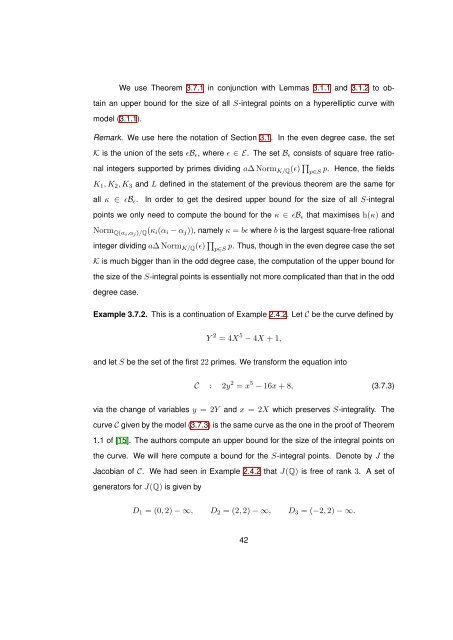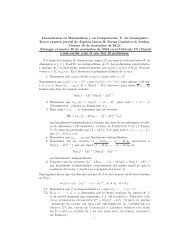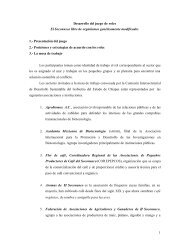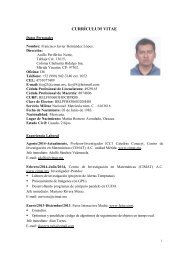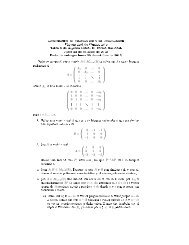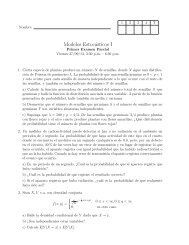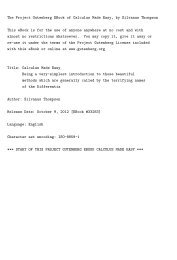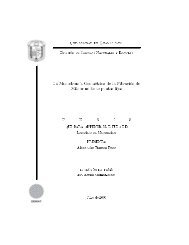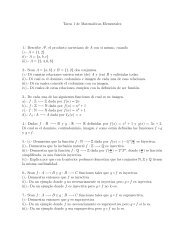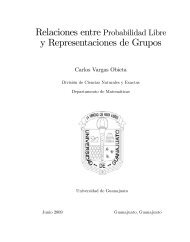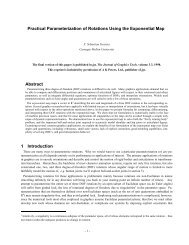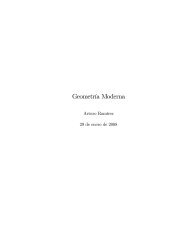S-integral points on hyperelliptic curves Homero Renato Gallegos ...
S-integral points on hyperelliptic curves Homero Renato Gallegos ...
S-integral points on hyperelliptic curves Homero Renato Gallegos ...
- No tags were found...
Create successful ePaper yourself
Turn your PDF publications into a flip-book with our unique Google optimized e-Paper software.
We use Theorem 3.7.1 in c<strong>on</strong>juncti<strong>on</strong> with Lemmas 3.1.1 and 3.1.2 to obtainan upper bound for the size of all S-<str<strong>on</strong>g>integral</str<strong>on</strong>g> <str<strong>on</strong>g>points</str<strong>on</strong>g> <strong>on</strong> a <strong>hyperelliptic</strong> curve withmodel (3.1.1).Remark. We use here the notati<strong>on</strong> of Secti<strong>on</strong> 3.1. In the even degree case, the setK is the uni<strong>on</strong> of the sets ɛB ɛ , where ɛ ∈ E. The set B ɛ c<strong>on</strong>sists of square free rati<strong>on</strong>alintegers supported by primes dividing a∆ Norm K/Q (ɛ) ∏ p∈Sp. Hence, the fieldsK 1 , K 2 , K 3 and L defined in the statement of the previous theorem are the same forall κ ∈ ɛB ɛ .In order to get the desired upper bound for the size of all S-<str<strong>on</strong>g>integral</str<strong>on</strong>g><str<strong>on</strong>g>points</str<strong>on</strong>g> we <strong>on</strong>ly need to compute the bound for the κ ∈ ɛB ɛ that maximises h(κ) andNorm Q(αi ,α j )/Q(κ i (α i − α j )), namely κ = bɛ where b is the largest square-free rati<strong>on</strong>alinteger dividing a∆ Norm K/Q (ɛ) ∏ p∈Sp. Thus, though in the even degree case the setK is much bigger than in the odd degree case, the computati<strong>on</strong> of the upper bound forthe size of the S-<str<strong>on</strong>g>integral</str<strong>on</strong>g> <str<strong>on</strong>g>points</str<strong>on</strong>g> is essentially not more complicated than that in the odddegree case.Example 3.7.2. This is a c<strong>on</strong>tinuati<strong>on</strong> of Example 2.4.2. Let C be the curve defined byY 2 = 4X 5 − 4X + 1,and let S be the set of the first 22 primes. We transform the equati<strong>on</strong> intoC : 2y 2 = x 5 − 16x + 8, (3.7.3)via the change of variables y = 2Y and x = 2X which preserves S-<str<strong>on</strong>g>integral</str<strong>on</strong>g>ity. Thecurve C given by the model (3.7.3) is the same curve as the <strong>on</strong>e in the proof of Theorem1.1 of [15]. The authors compute an upper bound for the size of the <str<strong>on</strong>g>integral</str<strong>on</strong>g> <str<strong>on</strong>g>points</str<strong>on</strong>g> <strong>on</strong>the curve. We will here compute a bound for the S-<str<strong>on</strong>g>integral</str<strong>on</strong>g> <str<strong>on</strong>g>points</str<strong>on</strong>g>. Denote by J theJacobian of C. We had seen in Example 2.4.2 that J(Q) is free of rank 3. A set ofgenerators for J(Q) is given byD 1 = (0, 2) − ∞, D 2 = (2, 2) − ∞, D 3 = (−2, 2) − ∞.42


